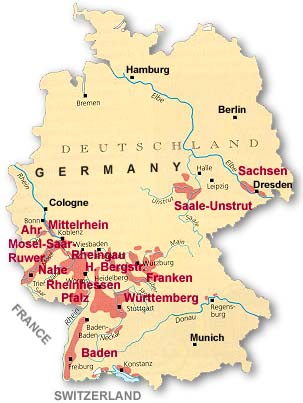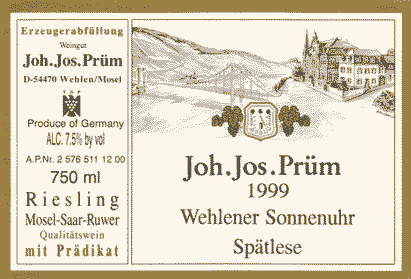German Wine
Contents
German wine overview
German vineyards are most well known for their white grape varieties:
- Riesling
- Müller-Thurgau (Rivaner)
- Silvaner (Sylvaner)
- Pinot Gris (Grauburgunder or Ruländer)
- Pino Blanc (Weissburgunder)
- Gewürtztraminer.
red wines are available, but are generally not as widely available as white wines:
- Pino Noir (Spätburgunder)
- Trollinger (Blauer Malvasier)
Regardless of the variety, when the grape name is stated on the label, 85% of the wine must be produced from that grape.
German wine growing regions

These regions are further divided into Bereiche, or sub-regions, which are comprised of groups of vineyards called Grosslagen.
German wine classifications
- Tafelwein: lowest quality wine meant to be consumed with a meal
- Landwein: a regional wine with a higher quality than that of Tafelwein
- Qualitätswein Bestimmter Anbaugebiete (QbA): commonly refered to as just Qualitätswein, this is wine produced from one of the 13 designated regions. It is from fully ripened grapes and the wine itself is tested by the German government for sugar and alcohol content.
A process called Chaptalization is commonly used with the above three classifications of wine, in which sugar is added to increase the alcohol content during fermentation. These wines tend not to be sweet and are usually labeled Trocken (dry) or Halbtroken (medium dry).
Qualitätswein mit Prädikat (QmP) - the highest quality German wines, subject to strict regulations governing their production. QmP are all-natural wines, in that there is no sugar added to the wine during the fermenting process. In order to produce a QmP wine, the grapes must contain enough natural sugars to complete the fermenting process. QmP wines are divided into these categories of increasing quality/sweetness:
- Kabinett
- Spätlese
- Auslese
- Beerenauslese (BA)
- Trockenbeerenauslese (TBA)
- Eiswein
deciphering German wine labels
German wine labels contain a host of information. Click on the parts of the label below for details:

Note: the dryness of this wine is not indicated on the label, which implies that it is a sweet wine. The taste / style or level of dryness of a wine depends on the cellar master and is determined in the cellar by the winemaker; it is totally independent of the grape.
Dryness levels are not to be confused with ripeness categories, which depend on the ripeness of the grapes harvested in the vineyard. Other notes:
- Trocken indicates dry wine without perceptible residual sweetness. It never contains more than 9 grams of residual sugar per liter and often less. It is very dry.
- Halbtrocken wines are semi-dry and may have no more than 18 grams of residual sugar per liter. With this barely perceptible sweetness, halbtrocken wines are considered "dry" by most wine lovers.